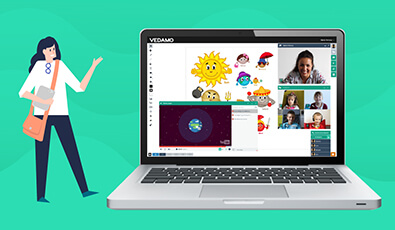

19.09.2018
By Veative
The future is a realm of all sorts of unimaginable possibilities. But it isn’t too difficult to answer the question of where VR will be in the next five years. The sector that arguably stands to gain the most from rapid developments in VR technology is that of education. What VR facilitates in the classroom is a synergistic confluence between our experience of reality and the fertile creativity of our imagination.
Whether it is by bringing ancient history to life, transporting students to distant parts of the world, or taking them on a fantastic voyage inside the human body, VR has already delivered on transforming teaching and learning experiences.

The future of VR in education, however, will be determined by the availability of quality VR content, grounded in solid pedagogical practices, and aimed towards developing cognitive skills in students and preparing them for the careers of tomorrow. With prices of headsets coming down significantly and more and more people waking up to the benefits of VR, one can reasonably conjecture that VR is poised to become a standard part of every classroom in the future.
We’ll start with just a few of the benefits that VR can bring to a classroom.
Greater depth in conceptual learning
Conceptual learning refers to acquiring and assimilating knowledge that goes beyond rote learning or a mere accumulation of facts. It is a form of learning through which students are able to grasp ideas and concepts that they can later on apply to new contexts. The use of VR can be critical in enabling students towards achieving greater depth in understanding conceptually rich subjects. Think about it, is it enough for students just to know the formal statements of Newton’s Three Laws of Motion? Wouldn’t it be better if students could see for themselves the application of those laws outside of a textbook? Learning enriched through the use of VR could provide that deeper level of connection with a concept.
Bridging learning gaps
Bridging learning gaps in a classroom full of diverse learners: Whether each and every student has a VR headset in a classroom is not the issue. The crucial question for educators will be how to provide the best learning experience for everyone in the classroom, in spite of their differences in proficiency level, pace of learning, learning style, and motivation. If a particular student does not understand a concept fully, there should be additional teaching tools available to the teacher to help bridge those learning gaps. With this in mind, the objective of providing students with access to an immersive environment is to make learning more engaging, interactive, and personalized.
A homogeneous setting is no longer the norm
In many classrooms around the world, a homogeneous setting is no longer the norm. It is time to address this fact, and allow technology to help level the playing field. Taking an immigrant child into the class and hoping for the best should rightfully become a thing of the past. If a Syrian student is placed into a Canadian classroom, their ability to succeed will be predicated on their language ability, either in French or English. With localization of content, it is now possible to have a child study a difficult topic such as Hybridization in Arabic, and once successful in grasping the concept, the child would then be required to replicate that in English. Once the content is understood, it is much easier to make that relatable in another language. This particular mode of learning not only helps the student, but also offers insights into the student’s ability (or lack thereof) to the teacher and sets them on a course of action together.
Conclusion: Content is Crucial
Beyond falling prices, there have been significant advancements in graphics and processing power, all factors which indicate a promising future for VR. However, the question of what the future holds for VR really comes down to content. The most important factors in creating a robust learning environment are, simply put, good quality immersive content, a rich diversity of topics, and sophisticated metrics of evaluation.
A library of good, vetted STEM content exists at the moment, charting an important course for the use of virtual reality in education. An expansion of this library to incorporate other subjects and fields of inquiry will be important for providing an impetus to a more sustained use of VR in the classroom. Set to take its rightful place alongside a pen and notebook, and PC and tablet, virtual reality holds the undeniable possibility of galvanizing educational ecosystems across the world. Considering that the future heralds lesser limitations in terms of tech specs, the way forward for VR will be to make a richly experiential mode of learning for everyone a rule and not an exception.



